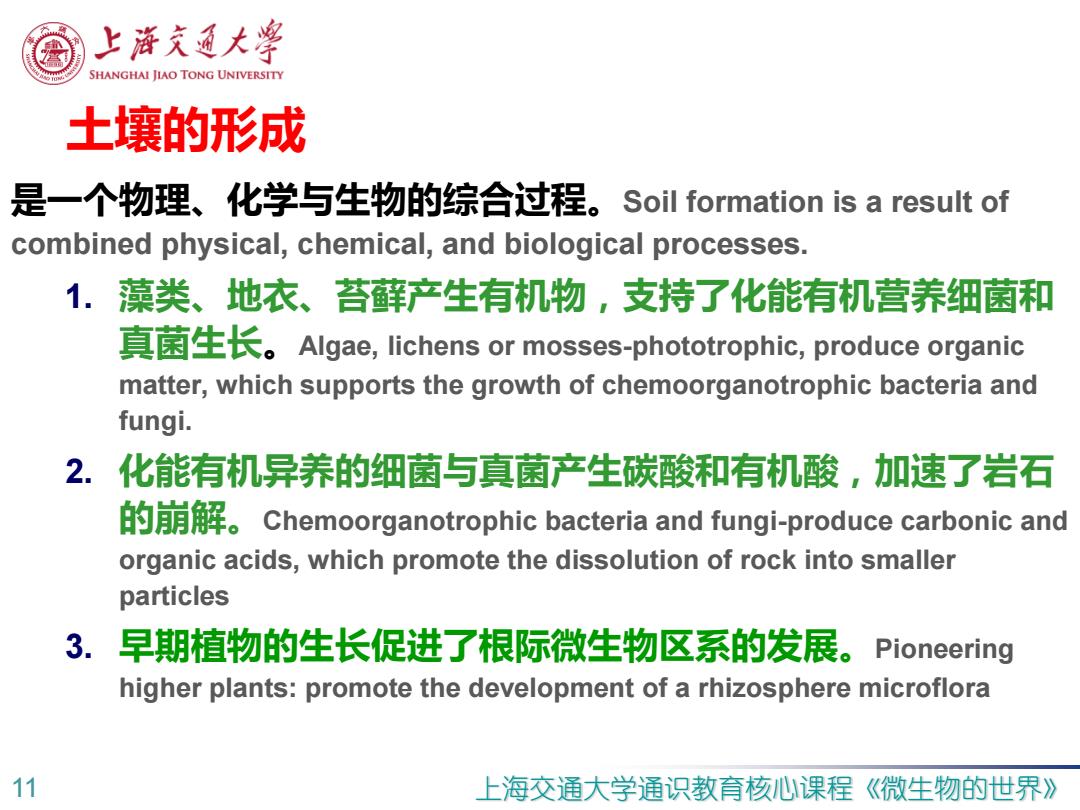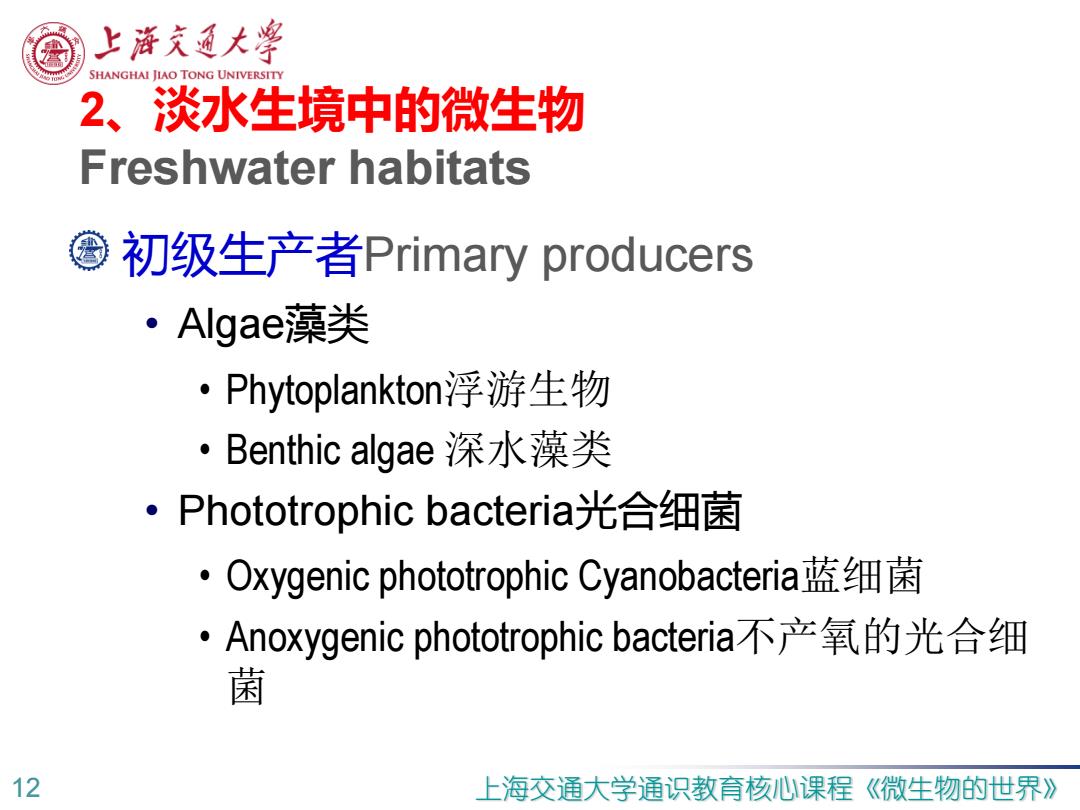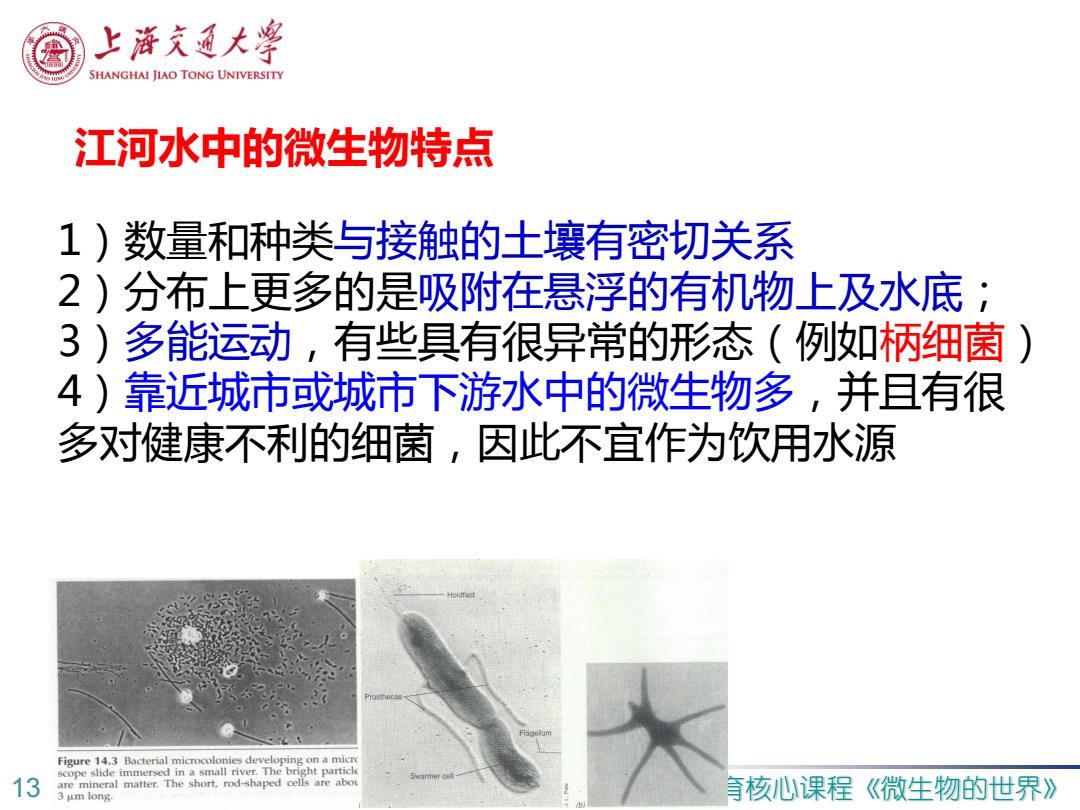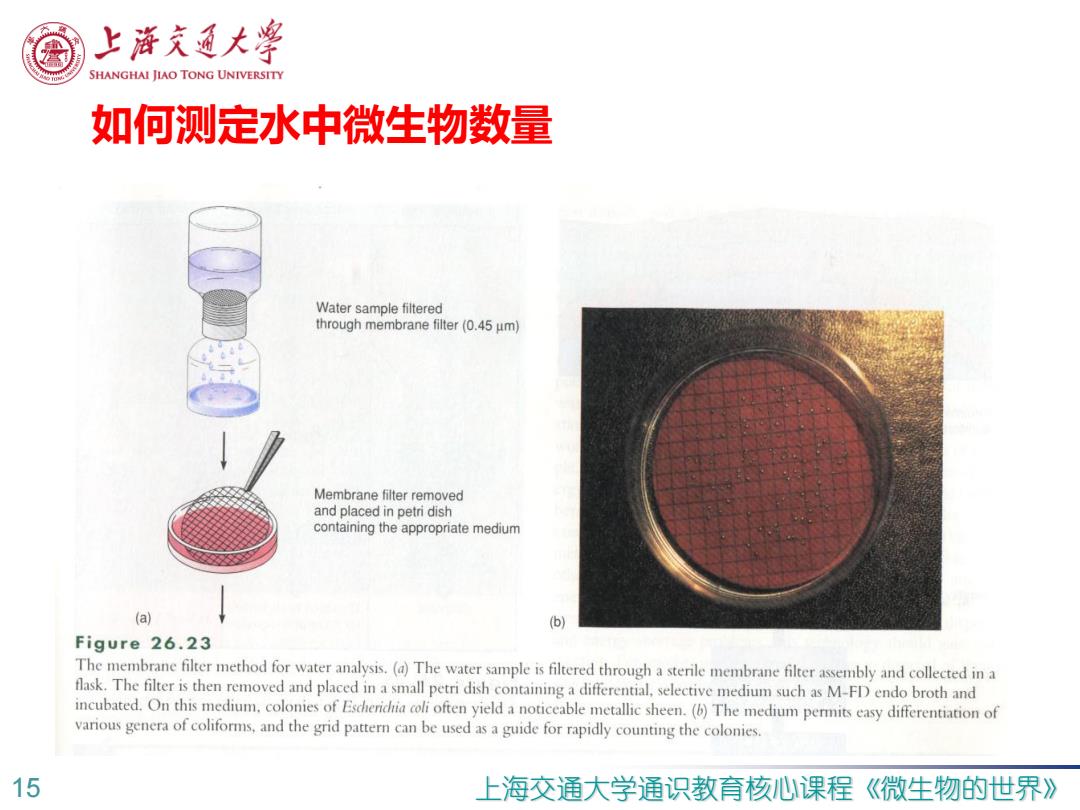
上游充通大学 SHANGHAI JIAO TONG UNIVERSITY 土壤的形成 是一个物理、化学与生物的综合过程。Soil formation is a result of combined physical,chemical,and biological processes. 1.藻类、地衣、苔藓产生有机物,支持了化能有机营养细菌和 真菌生长。Algae,lichens or mosses-.phototrophic,produce organic matter,which supports the growth of chemoorganotrophic bacteria and fungi. 2.化能有机异养的细菌与真菌产生碳酸和有机酸,加速了岩石 的崩解。 Chemoorganotrophic bacteria and fungi-produce carbonic and organic acids,which promote the dissolution of rock into smaller particles 3.早期植物的生长促进了根际微生物区系的发展。 Pioneering higher plants:promote the development of a rhizosphere microflora 11 上海交通大学通识教育核心课程 《微生物的世界》
11 上海交通大学通识教育核心课程《微生物的世界》 土壤的形成 是一个物理、化学与生物的综合过程。Soil formation is a result of combined physical, chemical, and biological processes. 1. 藻类、地衣、苔藓产生有机物,支持了化能有机营养细菌和 真菌生长。Algae, lichens or mosses-phototrophic, produce organic matter, which supports the growth of chemoorganotrophic bacteria and fungi. 2. 化能有机异养的细菌与真菌产生碳酸和有机酸,加速了岩石 的崩解。Chemoorganotrophic bacteria and fungi-produce carbonic and organic acids, which promote the dissolution of rock into smaller particles 3. 早期植物的生长促进了根际微生物区系的发展。Pioneering higher plants: promote the development of a rhizosphere microflora

上游充通大警 SHANGHAI JIAO TONG UNIVERSITY 2、淡水生境中的微生物 Freshwater habitats 初级生产者Primary producers ·Algae藻类 ·Phytoplankton浮游生物 ·Benthic algae深水藻类 ·Phototrophic bacteria:光合细菌 ·Oxygenic phototrophic Cyanobacteria蓝细菌 ·Anoxygenic phototrophic bacteria不产氧的光合细 菌 12 上海交通大学通识教育核心课程 《微生物的世界》
12 上海交通大学通识教育核心课程《微生物的世界》 2、淡水生境中的微生物 Freshwater habitats 初级生产者Primary producers • Algae藻类 • Phytoplankton浮游生物 • Benthic algae 深水藻类 • Phototrophic bacteria光合细菌 • Oxygenic phototrophic Cyanobacteria蓝细菌 • Anoxygenic phototrophic bacteria不产氧的光合细 菌

上游充通大警 SHANGHAI JIAO TONG UNIVERSITY 江河水中的微生物特点 1)数量和种类与接触的土壤有密切关系 2)分布上更多的是吸附在悬浮的有机物上及水底; 3)多能运动,有些具有很异常的形态(例如柄细菌 4)靠近城市或城市下游水中的微生物多,并且有很 多对健康不利的细菌,因此不宜作为饮用水源 Figure 14.3 Bacterial microcolonies developing on a micr scope slide immersed in a small river.The bright particle 13 are mineral matter.The short,rod-shaped cells are abot 3μm1ong 育核心课程 《微生物的世界》
13 上海交通大学通识教育核心课程《微生物的世界》 江河水中的微生物特点 1)数量和种类与接触的土壤有密切关系 2)分布上更多的是吸附在悬浮的有机物上及水底; 3)多能运动,有些具有很异常的形态(例如柄细菌) 4)靠近城市或城市下游水中的微生物多,并且有很 多对健康不利的细菌,因此不宜作为饮用水源

上游充通大警 SHANGHAI JIAO TONG UNIVERSITY 菲律宾1890-1935年伤寒热发病率 700 Filtration of drinking water 600 500 400 00000m 300 Chlorination of drinking water started 200 Carriers 100 discovered 1890 1900 1910 1920 1930 Years Figure 27.12 The incidence of typhoid fever in Philadel- phia,1890-1935.(Source:E.Steel,Water Supply and Sewerage, New York:McGraw-Hill,1953.) Why did the incidence of typhoid fever decrease? 14 上海交通大学通识教育核心课程 《微生物的世界》
14 上海交通大学通识教育核心课程《微生物的世界》 菲律宾1890-1935年伤寒热发病率

上游通大学 SHANGHAI JIAO TONG UNIVERSITY 如何测定水中微生物数量 Water sample filtered through membrane filter(0.45 um) Membrane filter removed and placed in petri dish containing the appropriate medium (a) (b) Figure 26.23 The membrane filter method for water analysis.(a)The water sample is filtered through a sterile membrane filter assembly and collected in a flask.The filter is then removed and placed in a small petri dish containing a differential,selective medium such as M-FD endo broth and incubated.On this medium.colonies of Eschericria coli often yield a noticeable metallic sheen.(b)The medium permits easy differentiation of various genera of coliforms,and the grid pattern can be used as a guide for rapidly counting the colonies. 15 上海交通大学通识教育核心课程 《微生物的世界》
15 上海交通大学通识教育核心课程《微生物的世界》 如何测定水中微生物数量